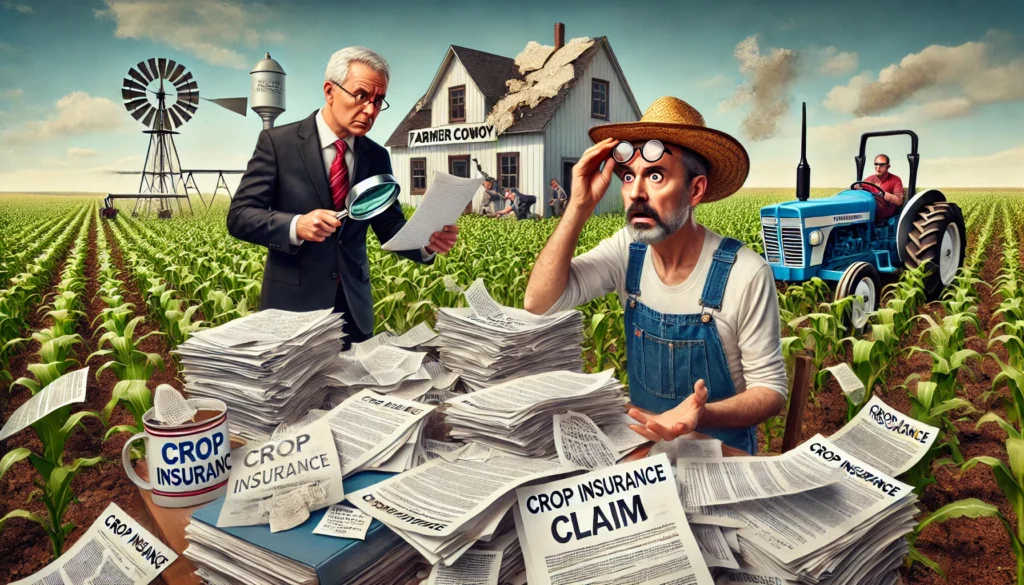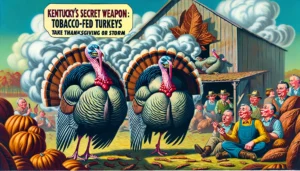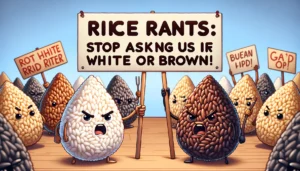
Crop Insurance A humorous and exaggerated scene depicting a farmer trying to file a crop insurance claim. The farmer is shown surrounded by piles of paperwork with 2.webp.webp
The Crop Insurance Comedy Show
A Farmer’s Guide to Guaranteed Uncertainty
Ladies and gentlemen, gather ’round, because today we’re diving into the hilarious world of crop insurance—a subject that’s sure to make you laugh, cry, and possibly reconsider your career choices. Now, I know what you’re thinking: “Crop insurance? That’s about as exciting as watching corn grow!” But trust me, when you peel back the layers, there’s more comedy gold here than you might expect.
If crop insurance were a superhero, its superpower would be ‘delayed reaction.’ By the time it shows up, the villain’s already gone.
The Sales Pitch: The Fun Starts Here
Let’s start with the sales pitch. Picture this: A slick insurance agent rolls up to your farm in a shiny new car that’s never seen a dirt road, and he’s wearing a suit so crisp it could slice through butter. He walks up to you with a smile that says, “I’m here to help,” but his eyes say, “I’m here to help myself.” He starts talking about crop insurance, making it sound like it’s the best thing since sliced bread—or at least since genetically modified wheat.
He’ll tell you all about how crop insurance is designed to protect you from the whims of Mother Nature. Hailstorm wipes out your corn? No problem! Flood turns your wheat field into a rice paddy? They’ve got you covered! Drought makes your soybeans look like raisins? Crop insurance to the rescue!
But here’s where the fun begins. The more he talks, the more you realize that crop insurance isn’t so much about protecting your crops as it is about protecting the insurance company. It’s like buying a bulletproof vest made out of paper—sure, it might stop a spitball, but good luck if you’re up against anything more substantial.
The Fine Print: A Comedy of Clauses
Ah, the fine print—where dreams go to die. If you’ve ever tried to read a crop insurance policy, you know it’s like trying to decipher ancient hieroglyphics after three cups of coffee and no sleep. The language is so convoluted, you half expect to find a clause about the alignment of the planets affecting your coverage.
Here’s a classic example: “In the event of a natural disaster, coverage will only be provided if the event occurs on the third Tuesday of a month that ends in ‘Y,’ and only if the wind is blowing at a speed of 7.3 miles per hour from the southeast.” You might as well hire a meteorologist and a calendar specialist just to figure out if you’re covered.
And then there’s the deductible. Oh, the deductible! You see, crop insurance companies love deductibles like a cow loves fresh grass. They’ll say, “We’ll cover your losses, minus the deductible, of course.” But that deductible is like a magician’s disappearing act—it starts off small and manageable, and then suddenly, poof! It’s so big, you wonder if it’s trying to rival your mortgage.
The only thing more complicated than a crop insurance policy is trying to explain it to your spouse after a disaster strikes.

The Claim Process: A Comedy of Errors
Now, let’s say disaster strikes. Your crops are flattened by a freak hailstorm that the insurance agent assured you was statistically impossible. You decide to file a claim. Sounds simple, right? Wrong. Filing a crop insurance claim is like auditioning for a reality TV show—there’s a lot of drama, a lot of waiting, and no guarantee you’ll get anything out of it.
First, you’ll be asked to provide proof that your crops were actually damaged. Because, you know, the 50 acres of flattened corn right behind you might just be an elaborate hoax. You’ll need photos, weather reports, soil samples, and possibly a sworn statement from the local weatherman confirming that, yes, the storm actually happened.
Then comes the inspection. An adjuster will be sent out to assess the damage. He’ll arrive three weeks later, long after the damage has been done, the crops have rotted, and you’ve started contemplating a career in something less stressful—like lion taming. The adjuster will poke around your fields with a clipboard, take a few notes, and then tell you that the damage doesn’t quite meet the criteria for a payout.
“What criteria?” you ask.
“Well,” he says, flipping through his paperwork, “according to our policy, the damage needs to affect at least 75% of your crop, but not more than 90%. And it needs to be caused by a weather event that’s been officially classified as a ‘significant meteorological phenomenon,’ but not a ‘catastrophic atmospheric disturbance.’”
In other words, you’re out of luck.
The Payout: Or Lack Thereof
But let’s say, by some miracle, you manage to navigate the claim process and get approved for a payout. Congratulations! You’re now eligible for compensation—just don’t expect it to cover your actual losses.
Crop insurance payouts are like those tiny cups of water they hand out at marathons—nice in theory, but hardly enough to keep you going. The insurance company will calculate your payout based on a complex formula that involves the market price of your crop, the average yield, the square root of the moon’s gravitational pull, and the number of times you’ve called customer service in the past month.
When the check finally arrives, it’ll be so small you’ll wonder if they accidentally sent you a rebate for a bag of seeds instead. You’ll cash it, of course, but it won’t cover much more than the gas it took to drive to the bank.
They say crop insurance gives you peace of mind. Sure, as long as your mind is okay with high blood pressure and sleepless nights.
The Aftermath: Lessons Learned (Or Not)
So, what have we learned from this little adventure in crop insurance? For starters, crop insurance is a lot like playing the lottery—everyone hopes to win, but most people end up disappointed. You pay your premiums, cross your fingers, and pray that the weather gods are on your side. But when disaster strikes, you quickly realize that the odds of getting a decent payout are about as good as finding a needle in a haystack.
And yet, despite all the headaches, all the hoops you have to jump through, and all the fine print that makes your head spin, farmers keep buying crop insurance. Why? Because, like it or not, it’s better than nothing. It’s a safety net—albeit one with a few holes in it—that helps keep the farm afloat when things go south.
But let’s be real: If you’re relying on crop insurance to save the day, you’re probably going to need a backup plan. Maybe it’s time to diversify your farm with some goats. Or alpacas. Or maybe just invest in a really good umbrella.
The Final Laugh: A Farmer’s Take
At the end of the day, crop insurance is one of those things that’s both frustrating and funny. Frustrating because it never quite lives up to its promises, and funny because, well, what else can you do but laugh?
So the next time you’re sitting in your barn, staring at a pile of paperwork, wondering if that insurance policy you bought is worth the paper it’s printed on, just remember: Crop insurance is like a joke that doesn’t always land—but when it does, it’s comedy gold.
Or at least bronze. Maybe copper. Okay, fine, it’s comedy aluminum foil. But hey, in the world of farming, you take what you can get.
15 Insightful Observations on Crop Insurance
- Crop insurance is like a seatbelt made of tissue paper—technically it’s there, but you wouldn’t want to test it in a crash.
- Filing a crop insurance claim is like trying to teach a cow to tap dance—no matter how hard you try, it’s going to be a mess.
- Crop insurance deductibles are like the elusive pot of gold at the end of the rainbow—good luck finding them, and even if you do, they’re not what you imagined.
- They say crop insurance gives you peace of mind. Sure, as long as your mind is okay with high blood pressure and sleepless nights.
- Getting a payout from crop insurance is like winning the lottery, but instead of millions, you get just enough to buy a nice lunch.
- Crop insurance policies are written in a language only lawyers and cryptographers understand—if you can decode it, you probably deserve a medal.
- You know you’re in trouble when your crop insurance agent starts a sentence with, ‘Technically, you’re covered, but…’
- The only thing more complicated than a crop insurance policy is trying to explain it to your spouse after a disaster strikes.
- Crop insurance adjusters are like rare birds—they show up when you least expect them, and just when you need them most, they fly away.
- Crop insurance is like buying a safety net with a few holes in it. It’ll catch you, but you might get a little banged up on the way down.
- If crop insurance were a superhero, its superpower would be ‘delayed reaction.’ By the time it shows up, the villain’s already gone.
- Trying to collect on crop insurance is like playing a game of hide-and-seek, except the insurance company is really good at hiding.
- Crop insurance agents are the only people who can turn a disaster into a paperwork party—and you’re the guest of honor.
- When the weather report says ‘100% chance of rain,’ your crop insurance policy says, ‘50% chance of coverage—conditions apply.’
- They say crop insurance is a safety net, but sometimes it feels more like a safety suggestion—strongly recommended, but not guaranteed.
Originally Published at FarmerCowboy.com
2024-08-21 06:56:57
Karl Hoffman is a distinguished agriculturalist with over four decades of experience in sustainable farming practices. He holds a Ph.D. in Agronomy from Cornell University and has made significant contributions as a professor at Iowa State University. Hoffman’s groundbreaking research on integrated pest management and soil health has revolutionized modern agriculture. As a respected farm journalist, his column “Field Notes with Karl Hoffman” and his blog “The Modern Farmer” provide insightful, practical advice to a global audience. Hoffman’s work with the USDA and the United Nations FAO has enhanced food security worldwide. His awards include the USDA’s Distinguished Service Award and the World Food Prize, reflecting his profound impact on agriculture and sustainability.




